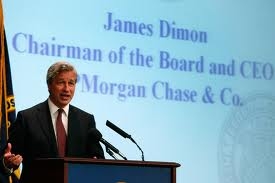CHASEing Elusive Profits
“Forty years ago, I asked a top executive at one of Morgan Chase’s predecessor banks, the old Morgan bank that merged with Chase to create the present behemoth, why his institution gambled so much on interest-rate movements. He replied instantly: ‘In case you hadn’t noticed, there aren’t a helluva lot of ways to make money in this business.’” Sanford Rose
Dolors & Sense
by Sanford Rose

KISSIMMEE Florida—(Weekly Hubris)—5/28/2012—For a few days (before Facebook), the equity market could talk about nothing else but the $2-plus-billion loss recently announced by JP Morgan Chase.
The loss savaged the bank’s stock and besmirched the reputation of banking Golden Boy, CEO James Dimon.
To understand the loss, one must appreciate the industry’s earnings outlook.
It sucks. Banks are earning sub-par returns on assets, and their return on invested capital is below the cost of that capital.
(Technical aside: A bank’s cost of capital, much higher than its cost of funds, is determined by the interaction of three variables: the riskless rate of interest, the premium that must typically be paid to people who choose to put their money in the stock market rather than leave it in riskless assets and something called “the beta,” which reflects the volatility of the individual company stock relative to that of the market as a whole.)
As long as banks earn less than their cost of capital, investors will dump bank stocks.
That creates a powerful incentive to produce earnings.
Forty years ago, I asked a top executive at one of Morgan Chase’s predecessor banks, the old Morgan bank that merged with Chase to create the present behemoth, why his institution gambled so much on interest-rate movements. He replied instantly: “In case you hadn’t noticed, there aren’t a helluva lot of ways to make money in this business.”
Plus ca change!
Banks today can’t lend much because loan demand is weak in the corporate area, where they are moderately anxious to lend, and stronger in the consumer area where, having been burned, they are not at all anxious to lend.
And even when they manage to lend, returns are constrained. Although banks can borrow money at virtually zero cost, the spread between their negligible borrowing cost and the lending rate is actually lower than it was in years past when they were forced to pay real money for their deposits and lendable funds. Otherwise stated, the low level of overall interest rates has depressed net interest margins.
Of course, banks are supposed to be able to gamble on interest rates, a la the Morgan bank of 40 years ago. It is now allegedly safer than it was then to borrow at a short maturity and lend at a longer one, profiting from the difference between short and long rates. It is safer because the Federal Reserve pledges to keep short rates at close to zero for at least the next two years, thus guaranteeing that the cost of refinancing a short-long position will not rise overmuch.
But herein lies an ironic tale. CEO James Dimon protests that his bank no longer plays the yield curve. The bank is supposedly match-funded: it borrows at the same yield maturity as that at which it lends.
I don’t really believe that—not entirely.
But to the extent that it is true, it may have foreclosed a nominal profit opportunity and thus pushed Chase into seeking far more aggressive gains in its trading of credit default swaps, which is where the $2-plus-billion loss appeared.
The point of all this is that a wounded lion is more dangerous than a healthy one.
The banking industry is bleeding from wounds, most of them self-inflicted, which are so grievous as to undermine the capacity for even gradual recovery.
It is thus more than ever likely to take steps that court extinction.
